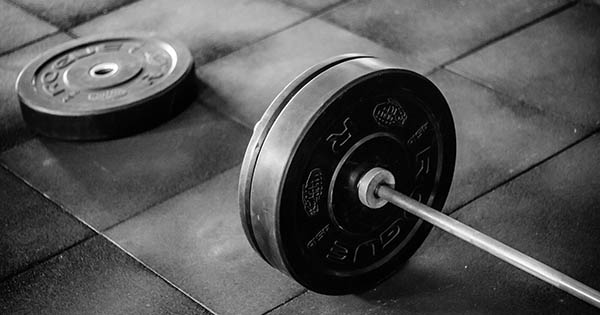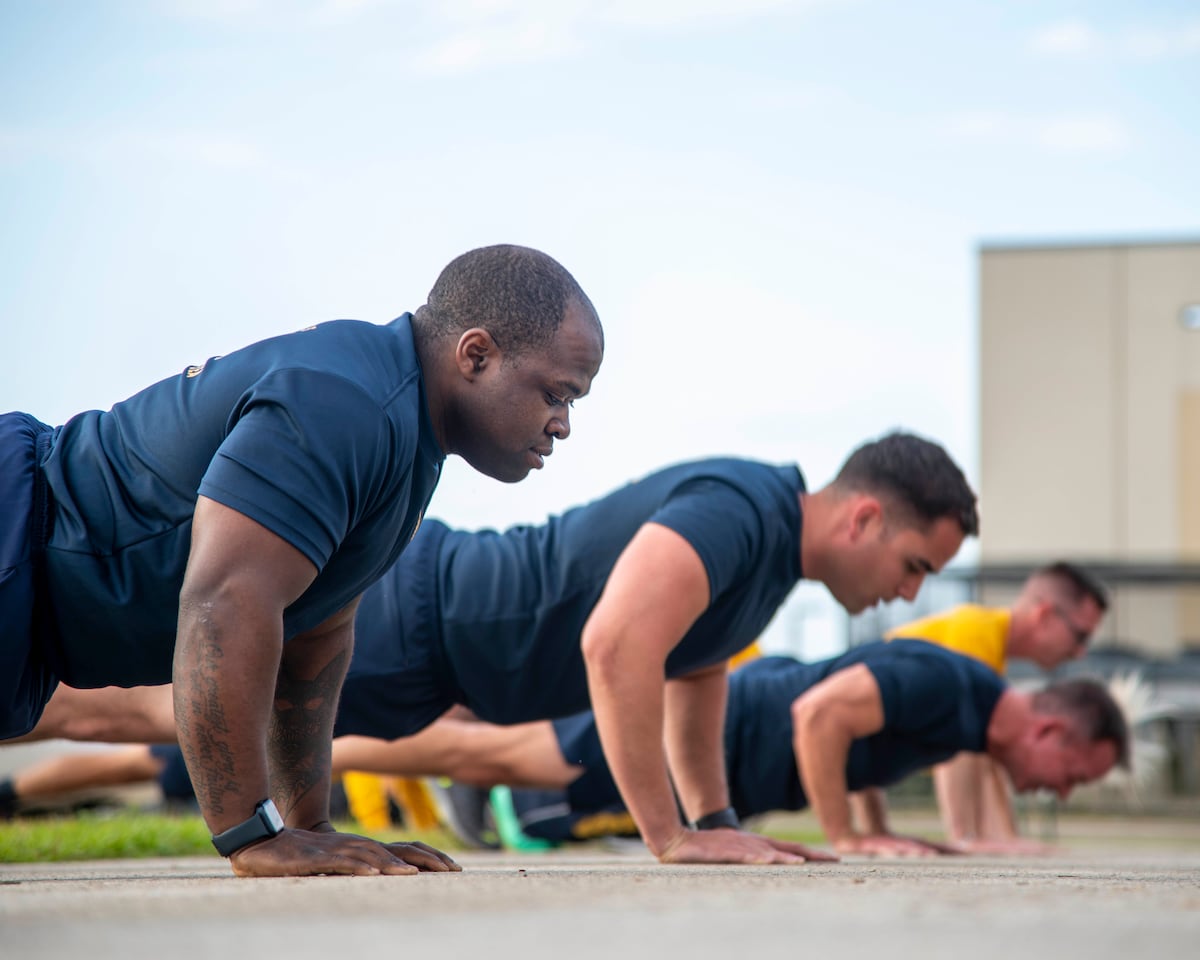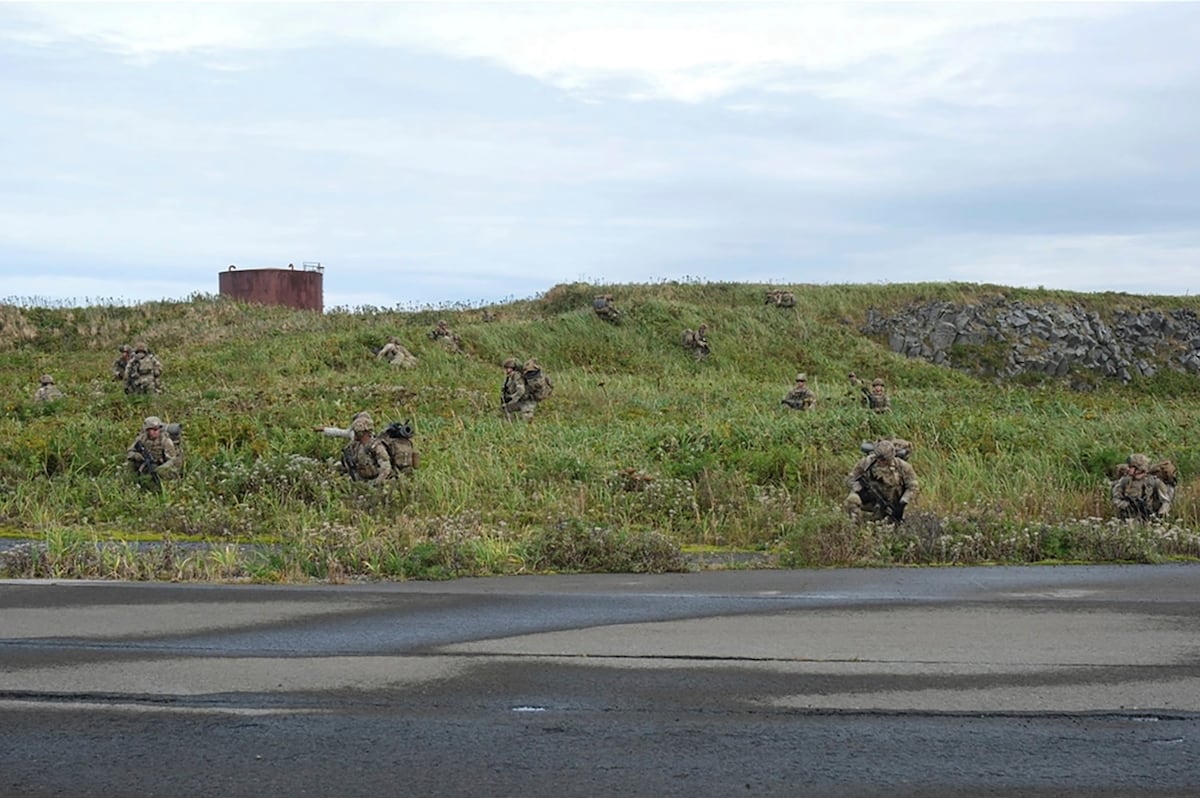Fitness
Former sergeant major of the Army talks fitness, fate of the leg tuck
:quality(70)/cloudfront-us-east-1.images.arcpublishing.com/archetype/IZBLTC57PJBQ7LW7DUE7BWMYJA.jpg)
Recently retired Sergeant Major of the Army Michael Grinston discussed Army fitness and nutrition in recent years and some unfinished business in those areas he hopes his successor will resolve.
“I left (Sergeant Major of the Army) Mike Wiemer a big, long list of stuff,” Grinston said.
Grinston was a guest on the podcast “MOPs & MOEs”, which released the episode Sunday. The podcast focuses on human performance, health and nutrition primarily for a military audience. It has previously featured other Army leaders and experts on those topics.
During the hour-long podcast, Grinston spoke about efforts he and his staff made to improve the quality, options and service at dining facilities across the Army, the Army Combat Fitness Test and the Holistic Health and Fitness program, also known as H2F. Grinston also took a moment to share his opinion on leg tucks, a feature of the original ACFT that was later cut from the program.
“I promise nobody in the Army fought harder to keep the leg tuck than me,” Grinston said. “I wouldn’t say insubordinate, but it was close.”
Podcast hosts Alex Morrow and Drew Hammond asked Grinston about successes and unfinished items in the health and fitness areas during his four-year tenure as the Army’s top enlisted leader.
Morrow is an Army Reserve officer who previously attended the Army Physical Fitness School while on active duty. Hammond is a strength and conditioning coach who has spent a career working as an embedded human performance professional within both special operations and conventional military units.
Grinston retired this summer after having served 36 years on active duty. Army Times recently reported that Grinston will become the first enlisted person to head the Army Emergency Relief Foundation when he takes over as the organization’s director on Jan. 1.
The retired sergeant major said he’d hoped a pilot program that provided prepared meals for soldiers from the dining facilities would have been implemented Army-wide. That effort is still in development.
The option, in place at Fort Liberty, North Carolina, allows soldiers to order meals for pickup online from their DFAC, saving time and helping soldiers who work shifts that prevent them from using the dining facilities during regular hours to receive a meal.
Morrow and Hammond asked about ways to reduce fast food, junk food and other unhealthy items on installations to improve nutrition options.
The sergeant major was well known for eating at DFACs when he traveled, calling out substandard food or cleanliness issues and giving challenge coins to NCOs he saw eating at the facilities.
He encouraged leaders to use the facilities to both monitor the state of their soldiers’ dining areas and to interact with soldiers outside of regular duties.
Grinston said his team worked to improve the entire nutrition ecosystem on installations, ensuring the quality of DFAC food was better, and commissary options such as salads, sandwiches and prepared meals were available. During his time as SMA, Grinston served on the Army and Air Force Exchange Service, or AFFES, which overseas commissary and restaurants on those services’ installations. While there, his focus was on educating soldiers to choose good nutrition options.
“Here’s my philosophy,” Grinston said. “Life’s about choices. I don’t think it’s my job to eliminate bad choices. What I want to do is make you so informed you choose wisely.”
Grinston was also a major supporter of the ACFT and the H2F program. The SMA posted his ACFT scores on social media and participated in physical training sessions with various units he visited on official trips.
This summer, weeks before his retirement, a congressional bill advanced that would have barred the ACFT from being the record PT test for soldiers and restored the decades-old Army Physical Fitness Test as the official test.
Grinston spoke out immediately, telling reporters that the new test was vastly superior to the old physical fitness test and necessary to change the culture of fitness within the Army.
In the recent podcast, he said returning to the APFT after the ACFT would be a huge step backward.
“Well, you might as well go back to the M1 Garand,” Grinston said, referencing a rifle soldiers used in World War II.
As far as the leg tuck comments are concerned, Grinston said he fought to keep it and cited a RAND Corporation study that endorsed the exercise.
The sergeant major said many who read the RAND study drew the wrong conclusions about using the leg tuck, a more difficult core strength exercise, over the plank.
The RAND study, released in 2022, reviewed 630,000 ACFT results and analyzed whether the test could predict success in combat tasks.
The leg tuck was determined as “not useful” in predicting combat task performance, lead author Dr. Chaitra Hardison told Army Times at the time.
But Grinston said the report noted if an individual couldn’t do a leg tuck, then evaluators didn’t have a way to assess core strength. That, however, was because the leg tuck includes upper body strength, core strength and grip strength.
“It rated higher than the plank because it’s a multiple-component exercise,” Grinston said.
The sergeant major pushed back on ongoing debates in which some say adding strength and conditioning coaches to brigades takes physical training authority away from NCOs.
But Grinston said that the expertise of such coaches is necessary for better physical training and should be seen as an added resource for NCOs to use when planning PT.
“I’ve heard this a little bit,” he said. “I usually tell people it’s pretty simple. If you gave your authority away, you gave it away, nobody took it from you.”
Todd South has written about crime, courts, government and the military for multiple publications since 2004 and was named a 2014 Pulitzer finalist for a co-written project on witness intimidation. Todd is a Marine veteran of the Iraq War.

Fitness
Learn These Beginner Weightlifting Exercises with BU Barbell Club

Nicolas Rocca
is a social media video creator with BU’s Office of Public Relations, producing short-form content for the university’s flagship social media channels. He grew up near Boston and received a bachelor’s degree in media arts production from Emerson College. In his free time, Nick enjoys hiking, scuba diving and photography. Nick can be reached at nrocca@bu.edu.
Profile
Fitness
New mums are being ‘strongly encouraged’ to take regular exercise and get more sleep. Don’t make me laugh | Rhiannon Lucy Cosslett

One of the many things you don’t realise until you have a newborn is just how much people congratulate you simply for leaving the house. “Well done for getting out and about,” they say, with the cheerful camaraderie of People Who Know. Going outside may sound like a low benchmark, but during those early weeks summoning the energy to put on clothes, pack a bag, and then using that narrow window between sleeping, feeding, pooing and screaming to cross the threshold into the world can feel like the grand sum total of all human endeavour. Screw the frescoes of the Scrovegni chapel: Mama made it to Budgens.
Which explains my reaction when I read that new guidelines published in the British Journal of Sports Medicine say that new mothers should be strongly encouraged to do at least two hours of moderate to vigorous exercise a week, in addition to “daily pelvic floor muscle training”, and further that they should develop a “healthy sleep hygiene routine”, avoid screen time and “maintain a dark, cool, quiet environment before bed”.
Hahahahahahahahahahahahahahahahahahahaha.
Where to start with this? Maybe with the phrase “strongly encouraged”, as though new mothers don’t get enough of that. In the absence of proper, structural support, strong encouragement is all society has. Take an anonymous call I received a few days after we were discharged from the hospital, still reeling from a complicated birth (when people ask what kind it was, I say: “I think maybe … all of them?”) I picked up the phone. “Hello?” I said, tentatively. I was in the bathroom at the time, observing the carnage of my life and body with the sort of stoned detachment that comes with zero sleep and opioid withdrawal. “HELLO. ARE YOU EXERCISING YOUR PELVIC FLOOR?” a woman bellowed down the line. “Who is this?” I said. “I AM CALLING FROM THE WHITTINGTON HOSPITAL. YOU NEED TO MAKE SURE YOU ARE DOING YOUR KEGELS. OK, BYE.”
In France, pelvic floor rehabilitation is a cornerstone of postnatal care, with the government providing physio sessions. Here, a midwife with a list of numbers and a robust phone manner yells at you about your ruined vagina. I still think fondly of her. But I think if she had also told me to do two hours of exercise and develop a healthy sleep routine as well, I’d have “strongly encouraged” her to do something else with her phone.
Look, I am not saying the advice isn’t important. As the professionals who have written this paper say, the postpartum period puts women at risk of all kinds of health problems, and is “a unique and critical window of opportunity to identify people at high risk for future chronic disease and to implement early interventions to improve lifelong health”. Of course it’s beneficial to become mobile as soon as possible after the birth, and to get as much sleep as you are physically able. New mothers know this. But they also know that achieving basic tasks, often in the absence of much support, can feel nigh-on impossible. Had I tried to develop their description of a healthy bedtime routine, I’d have basically been consigned to a dark room while my son did cluster feeding (and cluster pooing) for five hours. Is it any wonder I opted for binge-eating flapjacks in front of back-to-back Stanley Tucci: Searching for Italy?
When postpartum, in order to carve out time for exercise and sleep, you need a support system around you. You need visits from health professionals, an engaged partner who doesn’t go back to work after a mere two weeks, and your family around you (the paper acknowledges this, too). I was lucky enough to have this, and I still found it hard to find a moment for myself, so I can only imagine how hard it must be if you’re less supported. I expect these guidelines will just become another thing that many new mothers feel they are failing at, and the NCT agrees, saying that parents may find the pressure “overwhelming”.
I’ve just been reading Becky Barnicoat’s brilliant and hilarious Cry When the Baby Cries, a graphic memoir which vividly evokes those feverish, feral, fluid-soaked months after giving birth (she is an advocate, by the way, of achieving absolutely nothing as a survival tactic). There’s a part in the book where she goes for her postpartum doctor visit, six weeks after an emergency C-section, and he shames her for not doing exercise: “Most women like to get their bodies back as quickly as possible.” The following image, of her pushing the pram home with tears streaming down her face, viscerally captures the impact that a few unkind words can have on you at this time of deep vulnerability.
Too many of us have had moments like these, when someone could have been kind, but wasn’t. When it comes to guidelines for new mums, far less thought seems to be put into the manner of delivery. Sometimes “advice” is delivered so cruelly that it stays with you for years afterwards. There are many things I wish for postpartum women: better healthcare, better support (like in the Netherlands), better paternity leave, often, sadly, better husbands. But most of all, I wish people were a bit nicer to them.
What’s working
My son has been enjoying the new trampoline his dad gave him for his third birthday, especially to a soundtrack of disco music. It confirms my belief that, when parenting feels tricky, a “vibe shift” can work wonders. I was feeling emotional and exhausted yesterday, but watching him bounce, grinning, to Le Freak, somehow made everything feel OK again.
What’s not
Several good friends are dealing with toddlers who run off, sometimes towards traffic. Reins are largely frowned upon by this generation of parents (one friend even received judgmental comments for using them in the vicinity of actual lions while at a safari park), but it got me thinking how they did perform quite an important safety function. Is it time to rehabilitate them, or at least be a bit more understanding of one another?
Fitness
I’m a pregnant fitness trainer — the best exercises for easier childbirth, bladder control and preventing ab separation

They say that maintaining a healthy diet, getting lots of sleep and practicing breathing exercises can all make giving birth go a little smoother.
And while that may be good advice, Alissa Mosca, 33, a USA Weightlifting coach and a Planet Fitness trainer who is six months pregnant with her first child, says there are plenty of traditional exercises that can make bearing children a little easier to — well, bear.
“Exercises that engage your core, open the hips and activate the pelvic floor are all great for supporting childbirth,” Mosca told The Post.
Squat low
That means everyone’s favorite exercise — squats.
“Squats are an amazing exercise to continue throughout pregnancy,” she said, recommending bodyweight squats or using dumbbells or kettlebells for the versatility and range of motion.
“However, to get the full benefit, a full depth squat does need to be achieved,” she said. “This helps to open the hips, activate the adductor muscles and provide control over the pelvic floor.”
The pelvic floor is a group of muscles that provide crucial support to your bladder, womb and bowel.
Having a strong pelvic floor means you’ll be more prepared to push when the time comes — and it’ll provide some cushion for your growing baby while preventing incontinence issues.
Hip thrusts and glute bridges
That’s why two more exercises are also important exercises for expectant moms.
“Hip thrusts and glute bridges are two other great exercises to engage the pelvic floor,” Mosca said. “This helps to control the bladder as well, as it often gets more difficult to hold it the further along someone is or even through the night.”
Plank it out
For moms worried about the dreaded diastasis recti — which is when the abs stretch and separate due to pressure that your expanding uterus places on your abdominal muscles — Mosca recommends planking — as long as it feels comfortable.
“Keeping the core engaged will help prevent the separation of the abs that a lot of woman experience during childbirth or at least make it easier to rebuild afterward,” she said. “Often, the separation occurs due to a weak core.”
Ab work with a bump
Oblique side bends also make the list of pregnancy-safe core moves.
“Oblique side bends are another great exercise as it doesn’t put a lot of pressure on the center where the baby sits, but it helps support the outer abs (obliques),” she said.
And, last but not least, why not give reverse crunches — in which you lift your legs and hips into your chest — a try?
“To add a focus on the lower abs, reverse crunches are great, with added support under the glutes, as it activates the transverse abdominis — lower part of the abs that are much deeper inside — that support the stability of the baby bump,” she said.
It’s normal to be a little nervous about working out while pregnant — even Mosca wasn’t fully at ease with the idea at the start.
“In the first trimester, I wasn’t as comfortable doing things on the ground or contracting my stomach — more nerves than anything — but when I took the time to really listen to my body and try modifications, I was much more comfortable,” she previously told The Post.
“During the second trimester, I am more aware of my growing body, but I can still do things like burpees, pullups, push-ups, etc. I just need to take it a bit slower.”
These exercises will help you stay strong and hopefully pave the way for a smoother ride during labor and recovery — because childbirth really is the ultimate workout.
-

 News1 week ago
News1 week agoTrump Administration Ends Tracking of Kidnapped Ukrainian Children in Russia
-

 World1 week ago
World1 week agoCommission warns Alphabet and Apple they're breaking EU digital rules
-

 News1 week ago
News1 week agoZelenskyy says he plans to discuss Ukraine ceasefire violations in a call with Trump
-

 News1 week ago
News1 week agoTrump’s Ending of Hunter Biden’s Security Detail Raises Questions About Who Gets Protection
-

 Culture1 week ago
Culture1 week agoJack Draper’s tennis: How embracing variety took him to Indian Wells title
-

 World1 week ago
World1 week agoNASA astronauts return to Earth after 9 months: How space changes the body
-

 Technology1 week ago
Technology1 week agoGoogle’s Pixel Tablet is $120 off ahead of Amazon’s spring sales event
-

 Technology1 week ago
Technology1 week agoStreaming services keep getting more expensive: all the latest price increases




















